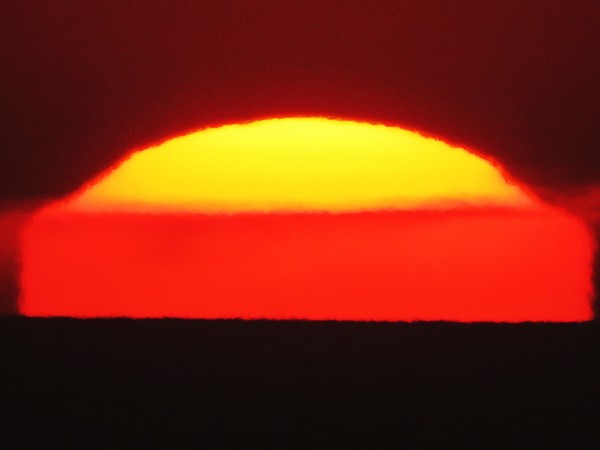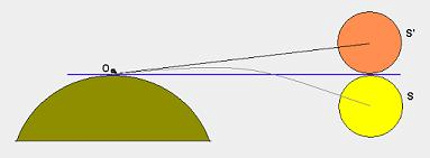
The September equinox happens at 6:50 UTC (1:50 a.m. CDT) on September 23, 2023.
Are day and night equal on the equinox?
Twice a year – on the March and September equinoxes – everyone worldwide supposedly receives exactly 12 hours of day and exactly 12 hours of night. But that’s not precisely true. In fact, there’s about eight more minutes of daylight – at mid-temperate latitudes – on the day of an equinox. And there are two reasons why. They are:
1. The sun is a disk, not a point.
Keep reading to learn more …
The sun is a disk, not a point
Watch any sunset, and you know the sun appears in Earth’s sky as a disk.
It’s not pointlike, as stars are, and yet – by definition – most almanacs regard sunrise as when the leading edge of the sun first touches the eastern horizon. They define sunset as when the sun’s trailing edge finally touches the western horizon.
This alone provides an extra 2 1/2 to 3 minutes of daylight at mid-temperate latitudes.

Atmospheric refraction and the equinox
The Earth’s atmosphere acts like a lens or prism, uplifting the sun about half a degree from its true geometrical position whenever the sun nears the horizon. Coincidentally, the sun’s angular diameter spans about half a degree, as well.
In other words, when you see the sun on the horizon, it’s actually just below the horizon geometrically.
What does atmospheric refraction mean for the length of daylight? It advances the sunrise and delays the sunset, adding nearly another six minutes of daylight at mid-temperate latitudes. Hence, more daylight than night at the equinox.
Astronomical almanacs usually don’t give sunrise or sunset times to the second. That’s because atmospheric refraction varies somewhat, depending on air temperature, humidity and barometric pressure. Lower temperature, higher humidity and higher barometric pressure all increase atmospheric refraction.
On the day of the equinox, the center of the sun would set about 12 hours after rising, given a level horizon, as at sea, and no atmospheric refraction.
What is an equilux?
Here’s a new word for you: equilux. The word is used to describe the day on which day and night are equal. The equilux happens a few to several days after the autumn equinox, and a few to several days before the spring equinox.
Much as earliest sunrises and latest sunsets vary with latitude, so the exact date of an equilux varies with latitude. That’s in contrast to the equinox itself, which is a whole-Earth event, happening at the same instant worldwide. At and near the equator, there is no equilux whatsoever, because the daylight period is over 12 hours long every day of the year.

Visit timeanddate.com for the approximate date of equal day and night at your latitude
Bottom line: There’s slightly more day than night on the day of an equinox. That’s because the sun is a disk, not a point of light, and because Earth’s atmosphere refracts (bends) sunlight.
Read more about the September 2023 equinox: All you need to know
The post On the equinox, are day and night equal? first appeared on EarthSky.
from EarthSky https://ift.tt/lX1AEnj

The September equinox happens at 6:50 UTC (1:50 a.m. CDT) on September 23, 2023.
Are day and night equal on the equinox?
Twice a year – on the March and September equinoxes – everyone worldwide supposedly receives exactly 12 hours of day and exactly 12 hours of night. But that’s not precisely true. In fact, there’s about eight more minutes of daylight – at mid-temperate latitudes – on the day of an equinox. And there are two reasons why. They are:
1. The sun is a disk, not a point.
Keep reading to learn more …
The sun is a disk, not a point
Watch any sunset, and you know the sun appears in Earth’s sky as a disk.
It’s not pointlike, as stars are, and yet – by definition – most almanacs regard sunrise as when the leading edge of the sun first touches the eastern horizon. They define sunset as when the sun’s trailing edge finally touches the western horizon.
This alone provides an extra 2 1/2 to 3 minutes of daylight at mid-temperate latitudes.

Atmospheric refraction and the equinox
The Earth’s atmosphere acts like a lens or prism, uplifting the sun about half a degree from its true geometrical position whenever the sun nears the horizon. Coincidentally, the sun’s angular diameter spans about half a degree, as well.
In other words, when you see the sun on the horizon, it’s actually just below the horizon geometrically.
What does atmospheric refraction mean for the length of daylight? It advances the sunrise and delays the sunset, adding nearly another six minutes of daylight at mid-temperate latitudes. Hence, more daylight than night at the equinox.
Astronomical almanacs usually don’t give sunrise or sunset times to the second. That’s because atmospheric refraction varies somewhat, depending on air temperature, humidity and barometric pressure. Lower temperature, higher humidity and higher barometric pressure all increase atmospheric refraction.
On the day of the equinox, the center of the sun would set about 12 hours after rising, given a level horizon, as at sea, and no atmospheric refraction.
What is an equilux?
Here’s a new word for you: equilux. The word is used to describe the day on which day and night are equal. The equilux happens a few to several days after the autumn equinox, and a few to several days before the spring equinox.
Much as earliest sunrises and latest sunsets vary with latitude, so the exact date of an equilux varies with latitude. That’s in contrast to the equinox itself, which is a whole-Earth event, happening at the same instant worldwide. At and near the equator, there is no equilux whatsoever, because the daylight period is over 12 hours long every day of the year.

Visit timeanddate.com for the approximate date of equal day and night at your latitude
Bottom line: There’s slightly more day than night on the day of an equinox. That’s because the sun is a disk, not a point of light, and because Earth’s atmosphere refracts (bends) sunlight.
Read more about the September 2023 equinox: All you need to know
The post On the equinox, are day and night equal? first appeared on EarthSky.
from EarthSky https://ift.tt/lX1AEnj

Aucun commentaire:
Enregistrer un commentaire